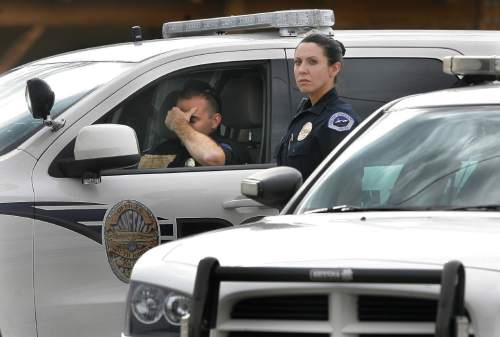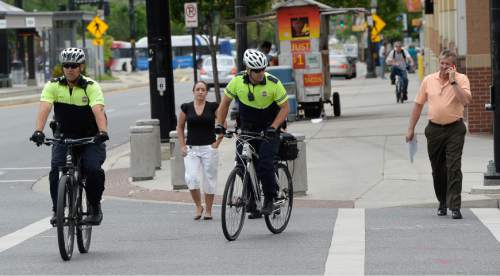This is an archived article that was published on sltrib.com in 2015, and information in the article may be outdated. It is provided only for personal research purposes and may not be reprinted.
Two new polls show that Salt Lake City residents generally don't perceive a major crime problem, but just how safe they feel depends on where they live.
West-side residents were far more likely to say they felt only somewhat safe walking in their neighborhoods during the day, while the vast majority of east-bench residents said they were very safe. Broadly, city residents felt less safe downtown and walking around their neighborhoods at night.
This comes from a poll conducted by Y2 Analytics in June for the Salt Lake City government. It appears to reinforce the results of a Salt Lake Tribune poll of registered voters in the city that took place in mid-July.
The newspaper survey asked voters whether they felt crime was under control, out of control, about average for a city of this size or better than average.
A majority — 51 percent — said it was about average, a neutral answer, while a quarter of respondents said it was either under control or better than average. Nearly a fifth (19 percent) said crime was out of control. The responses were steady across ages and gender, though conservatives were more likely (27 percent) than liberals (13 percent) to say crime was out of control.
If City Councilwoman Erin Mendenhall had to answer the question, she would say "about average" and she believes residents have a good sense of what is happening.
"The bottom line is what needed to be considered is public sentiment in collaboration with the data," she said. "It's our responsibility to be responsive to our constituents."
The FBI collects crime stats by city, but they're somewhat dated. The most recent numbers come from 2012. In cities with 150,000 to 200,000 residents (a pool of 47 cities), Salt Lake City, with about 190,000 residents, had the 14th highest violent crime rate, just below Grand Rapids, Mich. It had the third highest property crime rate, behind Little Rock, Ark.
Mendenhall said she regularly hears from residents who would like to see more cops on patrol. That's why she pushed to add eight new bike-patrol officers this sumer and eight social workers to assist the homeless population, which is largely concentrated in the Rio Grande neighborhood.
Expanding the police force was a major point of contention in this summer's budget negotiations.
In May, Michael Millard, the president of the Salt Lake City police union, released an open letter calling on the city to hire at least 25 more officers, due to population growth and increases in crime.
"Our officers are working feverishly," he said, "to keep up with the call volume."
But police administrators, using different stats over a longer period of time, insisted crime wasn't on the rise and said instead of more officers, they needed newer laptops and more squad cars.
"We are more fully staffed than we have ever been," Deputy Chief Tim Doubt said during a June news conference. "We feel like we're in a good position to take the call load we're getting."
The council took the middle road, adding four officers on bikes to the west side and four to the east side. The department received some new equipment. The council also agreed to bring on 15 additional officers if the city secures a federal grant, which won't be known until September.
Mendenhall and council colleagues Charlie Luke and Lisa Adams, all of whom represent the east side, heard from residents worried largely about property crimes and concerned that the concentration of police resources in the downtown area had slowed response times.
Millard and police administrators did not respond to calls for comment for this story.
The Tribune poll also asked respondents what they would support in a bid to increase public safety? Thirty percent favored more police in cars and 28 percent want boosted bike patrols. Nearly a fifth (18 percent) desire more officers walking beats and 16 percent said to leave things as they are. This question also seemed to have a political component, with a plurality of Republicans (45 percent) favoring more officers in cars, and a plurality of Democrats (33 percent) supporting officers on bicycles.
The Tribune poll, conducted by SurveyUSA, had a margin of error of 3.9 percentage points.
Tiffanie Provost, a business owner and member of the Pioneer Park Coalition, believes crime is out of control and that just adding more police officers won't solve the problem.
"The police officers in this area try very hard," she said. "I don't believe we have a solution to what to do once you arrest someone and how to prevent that someone from being released in 24 hours to commit a crime the next day."
She said conversations are underway about systemic changes to the downtown area, including talk of moving the homeless shelter.
The city's poll showed residents were less comfortable strolling around downtown. Only 47 percent said they felt very safe in the day and that dropped to just 20 percent when asked about walking around at night. Citywide, by contrast, 61 percent of residents felt safe walking in the daytime hours and 34 percent at night.
That poll had a margin of error of 3.35 percentage points.





